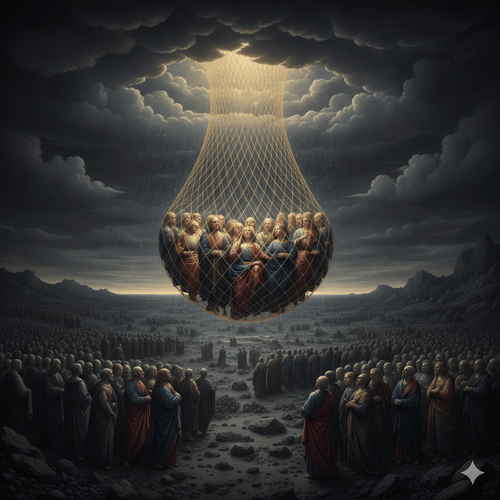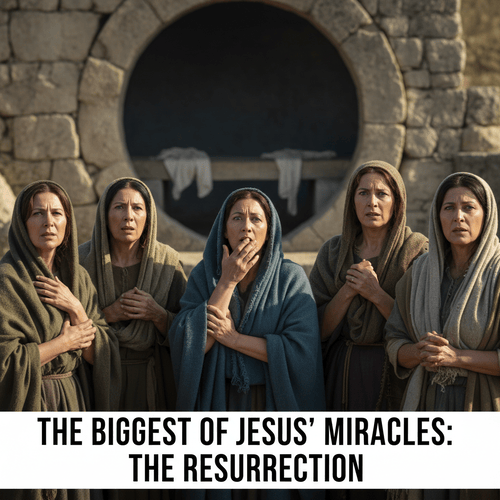The Miracles of Jesus: Why Sceptics Can’t Dismiss the Gospel Accounts
Critics often dismiss Jesus’ miracles as pious inventions by his followers, claiming the disciples fabricated supernatural stories to boost their religious movement. The sceptics’ theory may sound plausible at first glance, but crumbles under careful examination. The evidence from history, literature, psychology, and Bible scholarship builds an overwhelming case that the gospel miracle accounts represent authentic testimony, not creative fiction.
THE “INVENTION THEORY” FAILS HISTORICAL SCRUTINY
The Timeline Problem: The disciples simply didn’t have enough time to invent elaborate miracle stories. Paul’s first letter to the Corinthians, written around 55 AD, quotes an early Christian creed: “Christ died for our sins according to the Scriptures, that he was buried, that he was raised on the third day according to the Scriptures, and that he appeared to Peter, and then to the Twelve” (1 Corinthians 15:3-8). Scholars date this creed to within 2-5 years of Jesus’ death, when memories were still fresh and facts could be verified. Legendary development typically requires 2-3 generations to transform historical events into mythical tales, but Christianity’s core claims were already established within a few years.
Even Enemies Admitted the Miracles: Perhaps most telling is that Jesus’ opponents never denied His miraculous works—they only questioned their source. When the religious leaders plotted against Jesus, their concern wasn’t whether He performed miracles, but rather: “Here is this man performing many miraculous signs. If we let him go on like this, everyone will believe in him” (John 11:47-48). They attributed His power to Beelzebub or dismissed Him as a magician, but never claimed the events were fabricated. If the miracles were inventions, why didn’t hostile witnesses simply expose the fraud?
Too Many Witnesses, Too Little Space: Jesus ministered in small Palestinian communities where everyone knew everyone else’s business. The gospels name specific locations, times, and people involved in miraculous healings. Luke explicitly states he “carefully investigated everything from the beginning” and consulted “eyewitnesses and servants of the word” (Luke 1:1-4). In such tight-knit communities, with many witnesses still alive when the gospels were written, fabricating miracle stories would have been social suicide.
LITERARY EVIDENCE POINTS TO AUTHENTIC TESTIMONY
The Restraint Factor: Gospel miracle accounts are remarkably understated compared to later legendary writings. Second-century apocryphal gospels describe the child Jesus making clay birds come alive and stretching wooden beams to help his carpenter father. In contrast, the canonical gospels record miracles with sober precision, often including mundane details that serve no theological purpose—like Mark noting the crowd sat on “green grass” during the feeding of the 5,000 (Mark 6:39). This restraint suggests eyewitness memory rather than imaginative elaboration.
Embarrassing Honesty: The gospel writers preserved details that actually undermine their case if they were trying to manufacture a divine hero. Mark honestly records in Jesus’ hometown, “he could not do any miracles there, except lay his hands on a few sick people and heal them” (Mark 6:5). He describes a blind man’s healing that required two attempts: “Once more Jesus put his hands on the man’s eyes. Then his eyes were opened, his sight was restored, and he saw everything clearly” (Mark 8:25). Why include such potentially embarrassing details if you’re inventing stories?
Multiple Independent Sources: Modern scholarship identifies at least four independent sources behind our gospels: Mark, the Q source (shared by Matthew and Luke), material unique to Matthew (M), material unique to Luke (L), and John’s independent tradition. When multiple independent sources report the same basic claims, historians take notice. The consistent portrayal of Jesus as a miracle-worker across these diverse sources strongly suggests historical foundation rather than coordinated invention.
PSYCHOLOGICAL IMPLAUSIBILITY OF MASS DECEPTION
The Ultimate Test: Martyrdom: Here’s the psychological knockout punch against the invention theory: virtually all the apostles died horrible deaths for their testimony about Jesus’ miracles and resurrection. People might die for what they sincerely believe is true, but they don’t die for what they know is false. Stephen was stoned to death while declaring he saw “Jesus standing at the right hand of God” (Acts 7:54-60). If the disciples had fabricated miracle stories, would they really maintain the deception under torture and execution?
Character Transformation: The same cowardly disciples who “deserted him and fled” during Jesus’ arrest (Mark 14:50) later stood boldly before the same religious authorities who’d crucified their master. The formerly intimidated Peter declared to the high priest: “We cannot help speaking about what we have seen and heard” (Acts 4:20). Such dramatic personality transformation is psychologically implausible if based on known lies, but perfectly understandable if the Resurrection was witnessed truth.
Sustained Consistency: Maintaining a false story requires constant coordination and memory management. Yet despite facing interrogation, imprisonment, and execution across different regions and decades, the apostolic testimony remained remarkably consistent. No contradictory accounts emerged, no confessions of fraud surfaced, and no disciples broke ranks to expose the alleged deception.
THE “CRITERIA OF AUTHENTICITY” STRONGLY SUPPORT MIRACLE ACCOUNTS
Modern historians use specific criteria to evaluate ancient claims, and Jesus’ miracles pass these tests remarkably well.
- Multiple Attestation means the same basic claims appear across independent sources. Jesus’ miracle-working appears in every gospel tradition—healings, nature miracles, and exorcisms are consistently reported across all our sources.
- Dissimilarity examines whether reported events fit expected patterns. Jesus’ approach to miracles was strikingly different from contemporary magicians who used elaborate formulas, charged fees, or sought personal gain. Instead, Jesus instructed his followers: “Freely you have received; freely give” (Matthew 10:8).
- Coherence asks whether reported events fit the person’s overall message and mission. Jesus’ miracles perfectly complement his proclamation of God’s kingdom breaking into the world: “If I drive out demons by the finger of God, then the kingdom of God has come upon you” (Luke 11:20).
ALTERNATIVE EXPLANATIONS PROVE INADEQUATE
Naturalistic explanations attempt to explain away individual miracles but fail to account for the breadth and variety of supernatural events recorded. Meanwhile, theories about borrowed mythology collapse under examination—no genuine parallels exist for a suffering, crucified, and risen Messiah in ancient literature. As Paul noted, the Christian message was “a stumbling block to Jews and foolishness to Gentiles” (1 Corinthians 1:23), hardly the kind of appealing fiction someone would invent.
The Weight of Evidence: The convergence of historical, literary, and psychological evidence creates a powerful case for the reliability of gospel miracle accounts. Early dating, hostile witness testimony, literary restraint, embarrassing details, multiple sources, martyrdom willingness, and character transformation all point toward authentic testimony rather than pious invention.
John concludes his gospel by stating: “Jesus performed many other signs in the presence of his disciples, which are not recorded in this book. But these are written that you may believe that Jesus is the Messiah, the Son of God” (John 20:30-31). The challenge for sceptics is clear: provide a more convincing explanation for the uniform, early, and costly testimony about Jesus’ miraculous works than the obvious one—they actually happened.
THE MIRACLES OF JESUS: RELATED FAQs
What about the “copycat” theory—couldn’t Jesus’ miracles have been borrowed from pagan mystery religions? Christian apologists note alleged parallels between Jesus and pagan deities (Horus, Mithras, Dionysus) are largely fabricated by popular authors with no scholarly credentials. When examined closely, the supposed similarities dissolve—most “dying and rising gods” either didn’t actually die permanently or weren’t truly resurrected in bodily form. The few genuine parallels that exist (like healing miracles) are better explained by common human experiences of disease and recovery rather than literary borrowing.
- How do we know the gospel writers didn’t just copy miracle stories from the Old Testament? While Jesus’ miracles sometimes echo Old Testament events (like Elijah’s food multiplication), the differences are more striking than the similarities. Jesus performs miracles by His own authority rather than through prayer, heals immediately rather than gradually, and often does so in public rather than private settings. Christian scholars argue these parallels actually validate rather than undermine the accounts, showing Jesus as the fulfillment of Old Testament expectations rather than a mere copyist.
- Could mass hallucination or psychological suggestion explain the miracle accounts? Apologists point out hallucinations are highly individual experiences that don’t occur identically to large groups simultaneously. The gospels record miracles witnessed by diverse crowds including sceptics, enemies, and people with no prior expectation of supernatural events. Additionally, many miracles involved physical objects (food, wine, healed body parts) that multiple people could examine, making psychological explanation inadequate for the full range of reported phenomena.
- How can we trust miracle accounts when ancient people were more superstitious and gullible than modern people? This question reflects a chronological snobbery that apologists strongly challenge. Ancient people were actually quite familiar with natural death, disease, and physical limitations—they knew that blind people don’t suddenly see, dead people don’t come back to life, and small amounts of food don’t feed thousands. First-century Jews were particularly sceptical of miracle claims, which is why Jesus’ works caused such controversy. The apostle Thomas’s initial doubt about Jesus’ resurrection demonstrates that even Jesus’ closest followers weren’t gullible believers ready to accept any supernatural claim.
What about the “long gap” between Jesus’ ministry and when the gospels were written—couldn’t stories have been exaggerated over time? Apologists emphasise this gap wasn’t actually very long by ancient standards, with Mark likely written within 30-35 years of Jesus’ death. More importantly, oral tradition in first-century Jewish culture was highly reliable, with trained disciples memorising their rabbi’s teachings word-for-word. Paul’s letters, written even earlier, already assume knowledge of Jesus’ miraculous ministry, indicating these stories were circulating immediately rather than developing gradually over decades.
THE MIRACLES OF JESUS: OUR RELATED POSTS
Editor's Pick

Why Do People Hate the Doctrine of Election?
…WHEN THEY REALLY SHOULDN’T Few Bible doctrines provoke stronger reactions than election. The idea that God chose some for salvation [...]

The Doctrine of Providence: Does God Really Govern All Things?
You’re sitting in the doctor’s office when the diagnosis lands like a thunderclap. Your mind races: Why this? Why now? [...]

No Decay, No Defeat: What It Means That Christ’s Body Saw No Corruption
On the Day of Pentecost, Peter stood before thousands and made a startling claim: David's body decayed in the tomb, [...]
SUPPORT US:
Feel the Holy Spirit's gentle nudge to partner with us?
Donate Online:
Account Name: TRUTHS TO DIE FOR FOUNDATION
Account Number: 10243565459
Bank IFSC: IDFB0043391
Bank Name: IDFC FIRST BANK






